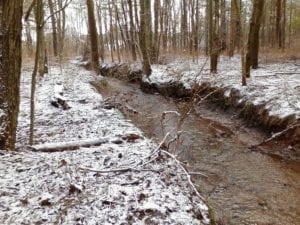Who is a member?
Our members are the local governments of Massachusetts and their elected and appointed leadership.

The town of Amherst has received more than $276,000 in funding to build a floodplain for the Fearing Brook.
With local teamwork and the help of a grant, the town of Amherst hopes to clean up the stormwater it sends into the Fort River and partially return an urban stream to its more rural past.
In October, the town was awarded more than $276,000 to slow down and clean the stormwater runoff that the Fearing Brook carries into the Fort River. The state awards these grants through the Nonpoint Source Competitive Grants Program, which is authorized under the federal Clean Water Act and funded by the U.S. Environmental Protection Agency.
The funds will allow Amherst to create a floodplain on town conservation land, in an area where the partly underground Fearing Brook sees daylight. About half of the downtown drains its stormwater into the brook, according to Assistant Town Manager David Ziomek, and the completed floodplain will help reduce erosion and absorb more pollutants and sediment before they end up in the Fort River.
“It’s an opportunity for a small town to make a really big difference on one ecological challenge,” Ziomek said.
The project, he said, will help answer an important question: “Can you turn back time to when it was a more natural watercourse?”
The Amherst grant was the second-largest of seven announced by the Baker-Polito administration on Oct. 25. The state awarded the other grants to the town of Spencer, the Pioneer Valley Planning Commission, UMass Amherst, the Franklin Regional Council of Governments, the Berkshire Regional Planning Commission, and Comprehensive Environmental Inc. of Bolton.
“Comprehensive watershed protection efforts like these are critical in order to keep our communities safe and healthy,” said Energy and Environmental Affairs Secretary Kathleen Theoharides in a statement about the grants. “These grants will help local officials and regional groups to protect and enhance vital local watershed resources from nonpoint source pollution.”
In Amherst, the effort to protect the Fort River will focus on disrupting the pollution between downtown and the river. Fearing Brook starts downtown and runs partly underground in a system of pipes, connected catch basins and culverts, Ziomek said. Above ground, the brook has sections where the banks are six feet and higher.
“Right now it’s a very deep ditch,” Ziomek said.
About five years ago, the town bought 20 acres of land for conservation near its East Village Center, and it will build the floodplain on this land. The plans include pulling down the tall banks, planting trees and native species to encourage absorption, and constructing walking trails. The town expects to complete the final design and bidding this winter and spring, and finish construction in 2021, Ziomek said.
He said the project is important because the Fort River is the state’s longest undammed tributary of the Connecticut River and is home to several state-listed species as well as the dwarf wedgemussel, a federal-listed endangered species.
“The Fort River is certainly in the top 10 rivers in the state in terms of natural diversity,” Ziomek said.
The project will also affect human activities, he said, because the river is a place for swimming, tubing and fishing, and it provides irrigation for local farms.
Several town departments will work together on the design administration and construction. The town also plans to collaborate with students and faculty from public schools and local colleges, and the work will provide educational opportunities for students.
“We really see this as a wonderful interdisciplinary project here in Amherst,” Ziomek said.